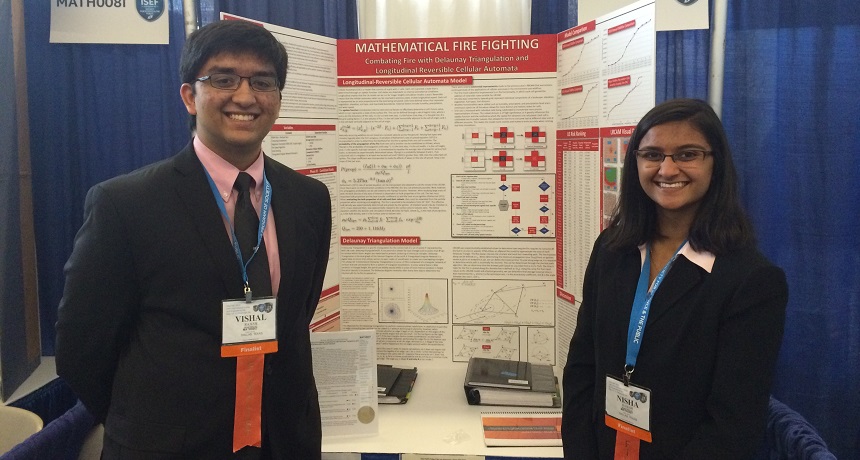Inspired to do research
Student scientists share their moments of inspiration

Brother and sister math pair Vishal Rajesh and Nisha Rajesh show off their work using math to predict how wildfires will spread.
B. Brookshire/SSP
PITTSBURGH, Pa. — This week, 1,702 high school students from more than 70 countries around the world gathered for the Intel International Science and Engineering Fair. Created by Society for Science & the Public (which publishes this blog and Science News for Students) and sponsored by Intel, the competition has been bringing teen scientists together for 65 years.
Here, in their own words, teens at this competition share what has inspired them to do research.
What inspires me to do research is the ability to gain numerical data from research. If you have a problem and you want to address it, and you want to fix it, you can’t contact others and ask for help unless you have proof there is a problem. Research gives you numerical data that is going to open people’s ears and make them listen to your problem.
– Drake Lawrence Bergeron, Ovey Comeaux High School, Lafayette, La.
We all know the ozone layer is very important to us. It protects us from ultraviolet rays. But holes may happen….This is very dangerous, we have to resolve it.
– Imen Nouri, Secondary Pilot High School, Gabes, Tunisia
What really inspires me to do research is helping other people, because I feel that’s the purpose of my life, to help other people. In this project I was working with ALS [ALS stands for amyotrophic lateral sclerosis. It is a disease that attacks and kills motor cells]….I was inspired by a dear family friend who has ALS right now. Seeing other people and watching them suffer connects me to them and makes me want to use science to my advantage to help them in any way possible.
– Shohini Bannerjee, Warwick High School, Lititz, Pa.
I believe that my research is inspired by the idea of helping people around the world and making the world a better place.
– Afeefah Fatimah Khazi-Syed, Harmony School of Innovation, Forth World, Texas
>
I am just a curious person and I like to know what’s going in the world around me.
– Brynn Myers, Oak Ridge High School, Oak Ridge, Mo.
I think mathematics is a very undervalued tool in the science fields in general. It has a broad scope and a lot of problems that are very significant in the world can be addressed with mathematics. Personally to me it’s very devastating to see how people are affected by natural phenomena. For example my project involves wildfires. I think math is a very important way we can address the problems and make the world a better place for everyone.
– Vishal Rajesh, Plano Senior High School, Plano, Texas
Ever since I was small, I’ve always had an interest in math. I’ve loved working with numbers. This is the best topic for me. As I’ve grown up I’ve realized how many problems there are in the world that can be related to math. I believe that math is not only an interesting topic but can be used as a very broad topic to look into multiple problems….We can look into problems that are developing in this world, and use the power of math to solve these problems.
— Nisha Rajesh, Jasper High School, Plano, Texas
Follow Eureka! Lab on Twitter
Power Words
(for more about Power Words, click here)
amyotrophic lateral sclerosis (or ALS)A disease that attacks and progressively kills motor nerve cells over time. These cells control the movements of many muscle groups. As the motor nerve cells die, people with ALS lose their ability to speak, walk and swallow. ALS is also sometimes called Lou Gehrig’s disease after the baseball player who was stricken with this disease.
ozone A colorless gas that forms high in the atmosphere and at ground level. When it forms at Earth’s surface, ozone is a pollutant that irritates eyes and lungs.
ozone layer A layer in Earth’s stratosphere. It contains a lot of ozone, which helps block much of the sun’s biologically damaging ultraviolet radiation.
Society for Science and the Public (or SSP) A nonprofit organization created in 1921 and based in Washington, D.C. Since its founding, SSP has been not only promoting public engagement in scientific research but also the public understanding of science. It created and continues to run three renowned science competitions, including the Intel International Science and Engineering Fair (initially launched in 1950). SSP also publishes award-winning journalism: in Science News (launched in 1922) and Science News for Students (created in 2003). Those magazines also host a series of blogs (including Eureka! Lab).
ultraviolet A portion of the light spectrum that is close to violet but invisible to the human eye.